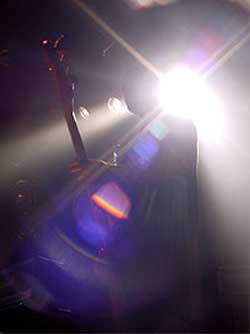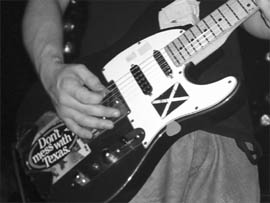"  Happy Songs or Happy People? – Mogwai 2003 "
Happy Songs or Happy People? – Mogwai 2003 "
Happy Songs or Happy People? With the release of Mogwai’s Happy Songs for Happy People in June, 2003, Jonathan Dekel was at the Melkweg to witness their latest live show and chat with the band.
"  Happy Songs or Happy People? – Mogwai 2003 "
Happy Songs or Happy People? – Mogwai 2003 "
Happy Songs or Happy People? With the release of Mogwai’s Happy Songs for Happy People in June, 2003, Jonathan Dekel was at the Melkweg to witness their latest live show and chat with the band.

There is a cardboard box circulating within the halls of the Melkweg. Weaving in and out of corridors and stairways, it finally arrives on a table in the middle of the backstage area. There it stays, unopened for roughly three minutes as various people bustle past it, until eventually its carrier, a label head from Mogwai’s European partner, Play It Again Sam announces, "Okay boys, here are the first copies of your album!" and hands the box around to the various band members, who all sit semi-bewildered by the piece of plastic in their hands.
"It’s…" Stuart begins,"…shiny!" John finishes. Everyone nods in agreement and the next few minutes are spent closely inspecting the inside of the booklet and case.
Its silver, semi-reflective cover has only the name of the band scribbled on it. ‘Mogwai’, it announces. This new logo is, of course, different from their last one; as it should be in the world of Mogwai. What is obtained inside is a whole other ball game compared to what Mogwai have attempted previously, but I’ll get back to that a bit later.
Approximately two hours earlier, Mogwai have just climbed on stage and the energy is strangely vibrant. The room is packed and as Mogwai launch into ‘You Don’t Know Jesus’ there is a sudden surprise. An undeniable force has suddenly connected and the room feels like it’s being sucked towards the stage. The lights flash on powerfully and the band are suddenly no longer humans, but silhouettes rocking back and forth to the sway of the pulsing sounds.
The audience too, seems to have lost itself to the general vibe that Mogwai is omitting and are being dragged into the swirling pool of sound waves one by one. As the song ends there are no pleasantries or introductions, simply because there is no microphone. This, of course, leads the audience to start conversing amongst themselves, leading the mic-less Stuart to ask them to shush. They semi-comply, and when the opening jabs of ‘Mogwai Fear Satan’ start to unleash themselves from the amplifiers, I brace myself and cannot wait to see the stunned faces of the crowd as the band breaks out mass-decibel hysteria.
Unfortunately, it doesn’t unfold as expected. There is a decibel regulation, as I later learn, which never allowed the band to truly reach their awesome peak. Instead, they are forced to settle for ¾ of the usual sound and a noisy audience. When they finally leave the stage after their encore, the show, to those who watched, seems amazing. However the band appeared slightly disappointed at the effort.

As a band and as a name, Mogwai creates hype simply because they are who they are, and what has come to be expected from them. Perhaps it is difficult to always live up to, both to their fans and to themselves, but they are innovators, practically single-handedly bringing post-rock into the mainstream. Like most bands though, they came together from simple beginnings; in this case from the surrounding areas of Glasgow, Scotland. Friends, Stuart Braithwaite [guitars / vocal noise emissions], Dominic Aitchison [guitar] and Martin Bulloch [drums] decided they wanted to form a band. John Cummings was soon drafted in as an additional guitarist, and their aim was simply "to make some serious guitar music". The goal was clearly reached, and later they added Barry Burns as a multi-instrumentalist to fill out the line-up.
After signing to The Delgados’ Chemikal Underground label (a move which almost single-handedly kept the label afloat and made it possible for them to promote further talent), they conquered local shores, before branching out with the help of Matador and established themselves in North America. The succession of popular albums and ever increasing audiences has spoken for itself since the late nineties, and instrumental rock music has never been so popular since the 70’s and that brand of Prog Rock, complete with ‘pan pipe solos’ and ‘faery dancing’. Their journey too, has in turn influenced other bands such as Sigúr Ros, Godspeed You Black Emperor, and Explosions in the Sky, allowing young music fans to explore sound manipulation and guitar music which shies away from the typical sounds and song structures of popular music.
More recently, the band parted with Chemikal on good terms and started their own imprint, Rock Action Records, as well as signing to PIAS, giving them the power to continue refining their sound, whilst also signing new bands which they like and believe in. This allows them to give something back to an industry which has so far been very kind to them, but more importantly is providing an opportunity for smaller bands to reach an audience they typically wouldn’t, partly because of the Mogwai ‘Stamp of Approval’.
This leads us back to 2003 in Amsterdam, almost two weeks away from the release date of Happy Songs for Happy People, where I was able to chat with John Cunningham before the gig.
John sits calmly across the table. We both take a swig from our beers and I ask what he thinks about the other bands who have been influenced by Mogwai?
"After Brit-pop became big, you couldn’t walk into a pub in Glasgow without hearing a band that sounded like Oasis or Blur…" John says with a slight laugh. "When Mogwai became big, I’m sure there were people elsewhere going, ‘Hey, I like this, lets try it!’ Mogwai isn’t the first band to do the soft-loud-soft thing though. There were others before us."
That "soft-loud-soft" thing John is referring was Mogwai’s style of songwriting from back in yesteryear. On their Chemikal Underground releases, it is highlighted as the songwriting tactic which almost embodied post-rock. However, in 1999 Mogwai turned their backs on that sound and released Come on Die Young. CODY pushed the band towards almost pop sensibilities, where the album’s highlight, and probably the most obvious example of this is the title track; a song which not only has vocals (something almost unheard of for the band) but also has a verse-chorus-verse structure.
After CODY, the band continued to evolve, eventually releasing 2001’s Rock Action. A critical success, it featured orchestration, celtic lyrics, and a generally softer Mogwai. To put it alternatively, Rock Action was the first Mogwai album you could play for your parents. However, the album itself seemed a mixed affair. The flow of the record was in constant fluctuation and it showcased a band unsure of their direction for the first time.
"I think Rock Action was a bit confused actually. We didn’t know where we wanted to go with it and as a result, it seemed to come out a bit mangled," John Admits. "We argued about how the mixing would go. Constantly going back into the studio and changing what the others had done before."
Along with hailing a quieter Mogwai, it also proved to be the first time in their career that the band would license their songs for commercial use, meaning segments were used on Sex and the City, and even a Japanese Levi’s commercial. Basically, it left some fans yelling, "Sell out!"
"People think we sold out for hundreds of thousands of dollars. The reports are way out of proportion. Levi’s gave us a fraction of the advertised price!" John says, seemingly a bit hurt. "…and the whole Sex and the City thing? We got nothing."
"Nothing?" I ask.
"When Sex and the City calls and asks for your music, they’re doing YOU a favour!" he says, smiling.
To remedy the chaos of Rock Action, the band decided to record their next record in Glasgow, at the expense of losing producer Dave Fridmann.
"We all decided we wanted to be closer to our family and friends; to have some time off at home and generally make it a better environment to write and record. I’m sad we lost Dave, however, I think we all needed to be in Glasgow." The result of these homegrown sessions is Happy Music for Happy People, a much more focused album than its predecessor. It is possibly softer at points, yet more together overall, featuring even more lush orchestration and a mumbled vocoder augmented through a Fender Rhodes. Overall, the songs just seem to live in much more harmony with one another.
"With Happy Songs for Happy People, we all came in, found what we believed was the best mix and just left it," John says, clearly satisfied. "The result, I think, is more cohesive. It’s generally happier!" John says, smiling at his own pun.
Much like their logo, Mogwai is ever evolving; ever pioneering a sound that in the end is so originally Mogwai that not even their greatest fans can mimic or describe. Perhaps it’s that essence which allows Mogwai to be, well, Mogwai.
Many journalists throughout the years have tried to describe their sound, yet none succeed. The best thing to do (those of you who were in the audience at the Melkweg show, take note) is just shut up and listen. Close your eyes, put on the CD and see what you find. It’s only then that you can understand what Mogwai is all about.
Jonathan Dekel & stevenmc
